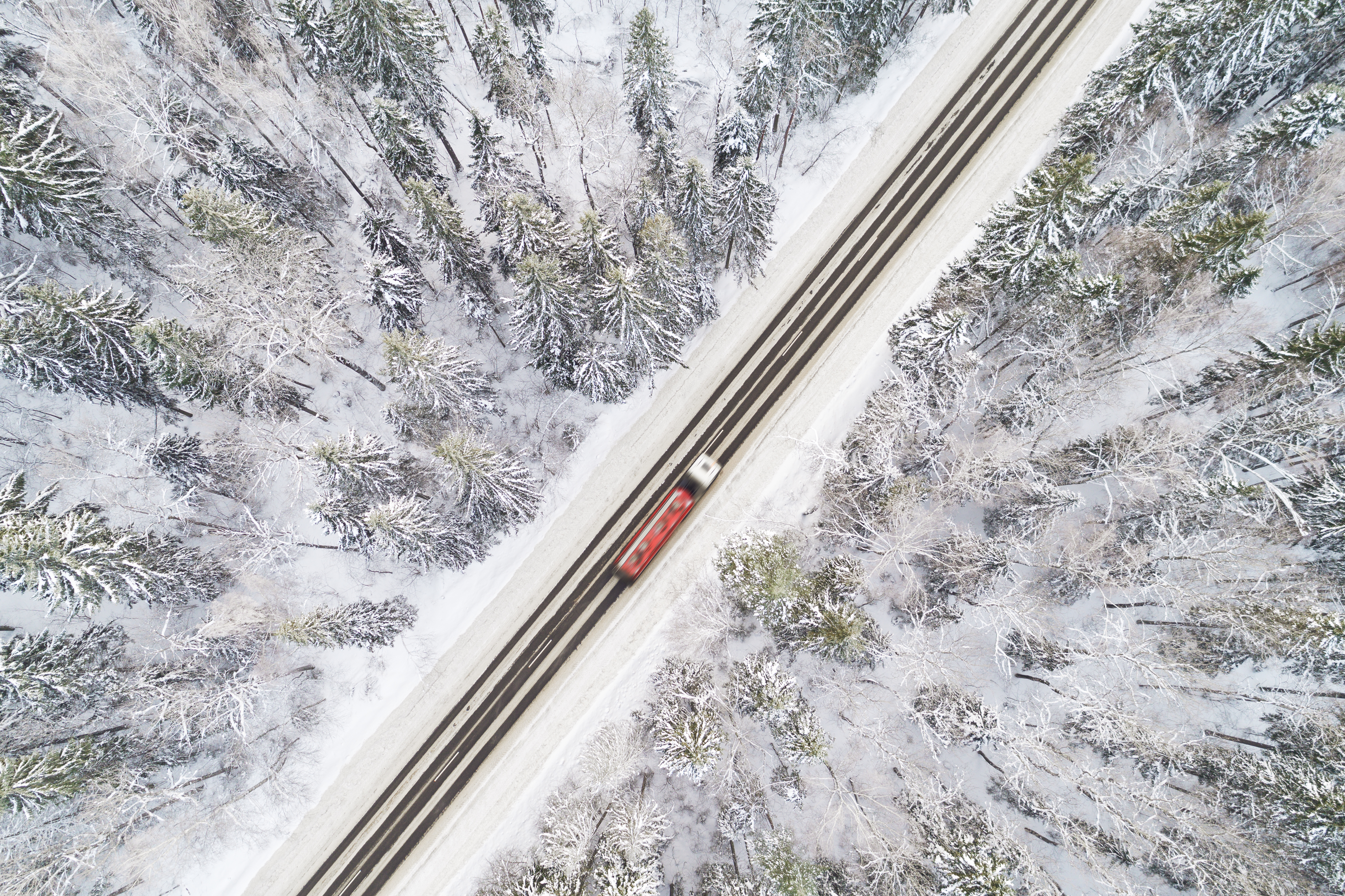
Miranda Blake
Vodnik voznika tovornjaka po zimi v Evropi
Ustvarjeno: 16. 10. 2024
•
Posodobljeno: 23. 12. 2025
Vozniki tovornjakov se v hladnejših letnih časih soočajo s posebnimi izzivi in odgovornostmi. Poveča se število hudih prometnih nesreč, saj se 33 % zavarovalnih zahtevkov, vloženih v tem času, šteje za hude.
Zato so priprave ključnega pomena. V tem poglavju vam svetujemo, kako lahko vozniki tovornjakov to zimo ostanejo varni na cesti in v kabini.
Plovba v nevihtnih razmerah
Ključno je, da vozite počasi in ohranjate varno razdaljo od drugih vozil - še posebej na poplavljenih območjih. Vozilo morate vključiti v nižjo prestavo in poskrbeti, da bo motor deloval z nizkimi vrtljaji.
Naslednji nasveti vam bodo pomagali tudi pri vožnji v nevihtnem vremenu.
- Če na vodni površini izgubite nadzor nad vozilom, upočasnite vožnjo tako, da spustite nogo s pedala za plin - ne poskušajte nenadoma zavirati ali krmiliti.
- Višja vozila so bolj občutljiva na močan veter - poskrbite, da boste trdno držali volan, in se izogibajte mostovom, če je le mogoče.
- Če je vaše vozilo prazno, potujte z odprtimi stranskimi zavesami. Na ta način je manj stvari, ki jih lahko ujame veter.
Upravljanje snega in ledu
Na ledu in snegu je treba zmanjšati hitrost vožnje in vzdrževati potrebno razdaljo do vozila pred seboj. Pravzaprav je priporočljivo, da zavorno razdaljo povečate na 10-kratnik običajne - vendar je to težko oceniti. Admiralova raziskava je pokazala, da črni led povzroči 10 % nesreč pozimi. Če vozite po črnem ledu, lahko to ugotovite, če je cesta videti mokra, vendar iz drugih vozil ne prši.
Drugi nasveti za vožnjo v snegu vključujejo redne preglede tovornjakov in zagotovitev vse potrebne opreme pred potjo, kot so kabli za preskok in orodje za odstranjevanje ledu. Poleg tega se vedno zavedajte, v kakšni opremi morate biti, saj vas to lahko reši pred izgubo nadzora nad tovornjakom. Na ravnih površinah vozite v najvišji možni prestavi. Pri vožnji navzdol uporabite motorno zavoro in vozite v nizkih prestavah. Da bi se izognili vrtenju koles, pri speljevanju uporabite višjo prestavo - tako boste zagotovili potreben oprijem za premikanje vozila.

Zagotavljanje vidnosti
Zaradi nevarnih avtocest in zunanjih dejavnikov, ki negativno vplivajo na vid in povzročajo nesreče tovornjakov, je vidljivost ključnega pomena v vseh vremenskih razmerah, še posebej, ko je hladneje. Zato preverite, ali so na vetrobranskem steklu odkruški ali razpoke, saj se lahko v hladnejših mesecih hitreje razširijo.
Poleg tega želite, da so vaše luči, registrska tablica in vetrobransko steklo čim bolje vidni. Poleg čiščenja snega in umazanije je pametno vozilo tudi redno umivati, da se ne bi nabirala cestna sol (ta povzroča korozijo).
Če je vidljivost slaba in razmere postanejo nevarne, je najbolje, da zapeljete s ceste in si odpočijete na najbližjem postajališču za tovornjake. Če boste na koncu morali preseči število ur vožnje, lahko uporabite posebno oprostitev za voznike, ki so obtičali v posebnih okoliščinah, kot so ekstremni vremenski dogodki.
Ocenjevanje globine tekalne plasti pnevmatik
Tudi nizke temperature lahko vplivajo na delovanje pnevmatik, saj lahko povzročijo zmanjšan zračni tlak. Obrabljene pnevmatike žal podaljšujejo zavorno pot in zmanjšujejo stabilnost na mokrih in poledenelih cestah, zaradi nizkega profila pa lahko pride do drsenja.
Zato je dobro, da pred vsakim potovanjem v nevihtnih in drugih težkih razmerah preverite globino tekalne plasti - tako boste vedeli, kdaj je treba odpraviti morebitne težave.
upoštevanje predpisov o zimskih pnevmatikah
Pomembno je poznati tudi različne predpise o zimskih pnevmatikah. V nekaterih državah morajo imeti vozniki s seboj vreče s peskom in lopate, v drugih pa so obvezne snežne verige. Continental je pripravil preprost vodnik po zahtevah za zimske pnevmatike za Združeno kraljestvo in Evropo.
Od 1. novembra so zimske pnevmatike obvezne v:
- Avstrija
- Češka republika
- Finska
- Francija
- Litva
- Srbija
V drugih državah so obvezne pozneje v mesecu ali decembra ali pa so odvisne od vremenskih razmer. Pnevmatike s čepi so v spodnjih državah sicer dovoljene, vendar veljajo zanje stroga pravila. Najbolje je, da pred potovanjem preverite predpise za posamezno državo.
- Avstrija
- Belorusija
- Danska
- Estonija
- Finska
- Francija
- Velika Britanija
- Latvija
- Lihtenštajn
- Litva
- Norveška
- Španija
- Švedska
- Švica
- Turčija
- Ukrajina
Prinesite ustrezne potrebščine
Razmisliti morate tudi o tem, kako lahko pozimi poskrbite zase. To se bo zdelo samoumevno, vendar poskrbite, da boste imeli dostop do zadostne količine hrane in pijače. Ker je v hladnejših letnih časih več možnosti za zapore cest, morda ne boste mogli vedno priti do postajališča za tovornjake. Pripravite si prigrizke ali obroke, po možnosti tudi vročo pijačo v bučki.
Če nimate dostopa do prostora za počitek, poskrbite, da vam bo toplo. S seboj na primer vzemite grelne obloge, ki jih je mogoče ponovno napolniti. Prav tako imejte vedno pri roki topla in rezervna oblačila; to vam bo še posebej koristilo, če se oblačila zaradi opravil, kot je odstranjevanje snega z vetrobranskega stekla, ohladijo in zmočijo.
Najbolje bi bilo, če bi imeli zimski komplet za preživetje, ki bi vseboval hrano, pijačo, prenosni polnilec za telefon, svetilko, odeje, zaščitni jopič, lopato in trpežne pohodne čevlje.
Zagotavljanje dostopa do postajališč z intruckom
Čeprav na vremenske razmere ne morete vplivati, pa lahko zaščitite sebe in druge na cesti. Pri tem se čim prej prepričajte, da imate na voljo varen in zanesljiv prostor za parkiranje. Naša aplikacija intruck ali stran z zemljevidi vam bo povedala bližnje ponudnike storitev skupaj z informacijami o objektih, ki jih vsak od njih ponuja.
Aplikacijo intruck lahko prenesete še danes s klikom na [to povezavo] (https://intruckapp.com/download/).



